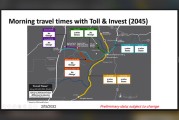People want traffic congestion relief from Interstate Bridge project
It’s becoming very clear that Portland and Metro officials are trying to get people out of their cars. Metro President Lynn Peterson and Portland Commissioner Jo Ann Hardesty have pushed to limit the Interstate Bridge Replacement (IBR) to three lanes, matching Portland’s lane restriction around the region. The current battle over the I-5 Rose Quarter project has been fiercely about not widening the freeway.
Over the years, there has been a great deal of discussion about Portland’s “war on cars.” There are many organizations like “No More Freeways” and Bike Portland, and many environmental groups like the Oregon Environmental Council all of whom fight against adding vehicle capacity. The groups and their members hope to reduce vehicle miles traveled (VMT) are part of their concerns over the environment and livability of Portland.
There is a much different mindset in most of Clark County, where few people consider transit a viable option. Many more people use cars for work and play. In the most recent IBR survey, 78 percent of Washington residents wanted a reduction in traffic congestion and time savings, as their top priority for the project.
The 2018 PEMCO survey showed that 94 percent of people preferred to use their privately owned vehicles. That was before the pandemic, when transit ridership plunged roughly 70 percent both locally and nationally.
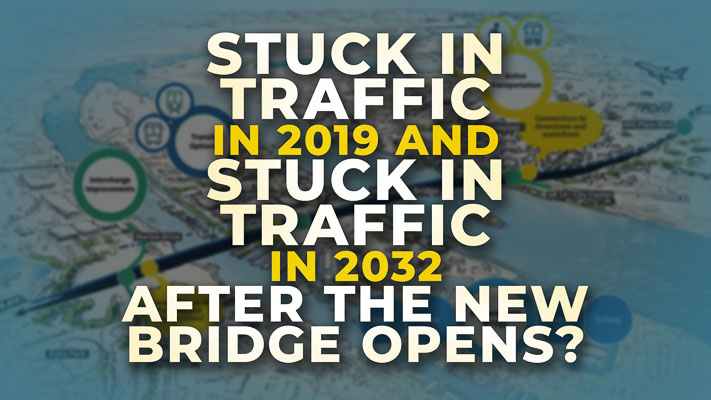
Chris Teso is the founder and chief executive of Chirpify, a Portland-based tech startup who lives in Portland. He says Portland needs to end its war on cars.
“The debate for me is statistical, not emotional,” Teso says. “Driving still makes the most sense for the most people.
“Despite the enormous amount of tax dollars spent on planning, building infrastructure, and marketing alternative forms of transportation, the number of cars on Portland roads has increased while the percentage of people choosing an alternative has decreased,” he said.
The push against cars from Portland
Last fall, Peterson and Hardesty sent a letter to the IBR team. They requested an analysis that “must include a review of the potential for high quality transit paired with congestion pricing at similar rates to other cities to effect transportation demand. This change in demand should inform bridge and highway design options.”
“We need to see analysis that looks at what is possible if we fully invest in transit capacity and access and integrate equitable congestion pricing,” the letter indicated.
“Now, make no doubt about it, we know that currently there’s 143,000 folks in cars that want to get through this (I-5) corridor,” Greg Johnson, IBR Administrator said. “We are not going to build something that is going to seek to punish them out of their vehicles. But what we’re looking to do is give people alternatives.”
In January, Metro Councilor Shirley Craddick wasn’t pleased. “Your data says we have a lot of cars and need a bigger bridge,” she said. “But we can no longer accommodate that and have a healthy world, or maybe even a world at all … We’re basically saying we can’t tolerate a bridge that is 10 or 12 lanes wide.”
At a February Black History Month presentation hosted by the IBR team, Hardesty made it clear she wants to get people out of their cars.
“I want to be really clear, my goal is to reduce people’s use of single vehicle travel miles in the city of Portland,” Hardesty said. “I don’t want to hide the fact that I want people out of their cars. But the only way we can get people out of their automobiles is to make sure that we have multimodal transportation options for the people who need it most.”
Portland City Councilor Jo Ann Hardesty shares that her top priority is safety. But it’s also about forcing people to get out of their cars. Video courtesy IBR
Contrast that with the response of Shawn Donaghy, CEO of C-TRAN and current chair of the Regional Transportation Council (RTC) Board. Last week, he and Johnson shared an update with the Camas City Council on the IBR project.
“I think it’s important to note that C-TRAN’s view of this is maybe a little bit different than some of our partners that are on the program,” Donaghy said. “C-TRAN’s goal is not to pull people out of their cars. Our goal is to try to find a space within the mode share that provides the most opportunity for all of the citizens in the county, or within Southwest Washington as a whole.”
Donaghy repeated his statement for emphasis. “Our goal is not to try to drive people out of their vehicles.” He also expressed a willingness to discuss third bridge corridors, once the IBR is underway.
Over the past half century, the Portland metro area has invested billions on “multimodal transportation options”. Their most recent addition was $1.5 billion for the Tilikum Crossing bridge over the Willamette River and creating the Milwaukie MAX light rail line.
Yet transit ridership has declined in both actual numbers and in percentage terms over the past few decades. Oregon Transportation Commissioner (OTC) Robert Van Brocklin recently said only 4 percent of people in Portland use transit. Regional voters rejected creating a new TriMet light rail line to Tigard and Tualatin just 16 months ago.
Johnson, IBR administrator, has said multiple times “you can’t build your way out of traffic congestion.” He’s merely repeating what WSDOT Secretary Roger Millar has said. “We cannot build our way out of congestion.”
Millar said highways won’t cure Washington state’s traffic woes and preventing congestion is impossible, in the summer of 2018. “Congestion is a problem we cannot solve,” he said at a meeting of the American Association of State Highway and Transportation Officials. That might seem odd coming from a man who manages billions of dollars of highway and freeway projects.
Citizens know one thing for sure. It’s been 40 years since new freeway capacity has been built in the Portland metro region, with the addition of I-205. The refusal to add vehicle capacity as the regional population has doubled, has only made traffic congestion worse. Portland is often among the nation’s top 10 worst cities for congestion.
Last month, a new report indicated traffic congestion in the Portland area cost $1.2 million a day.
According to the American Transportation Research Institute, three-Portland area spots have the distinction of landing on ATRI’s 100 Top Bottlenecks, despite the city’s freeways not carrying the largest number of vehicles in the country.
The organization lists the Rose Quarter interchange of Interstate 5 at I-84, and I-5 at the Columbia River at No. 28. The Interstate Bridge is listed as No. 33. Further down the list is I-5 at I-205 South at No. 83.
C-TRAN CEO Shawn Donaghy helps provide an update on the Interstate Bridge Replacement project to the Camas City Council recently. He indicated C-TRAN is not pushing to get people out of their cars, but instead hopes to provide transportation options for those who need it. Video courtesy city of Camas
I-205 project adds capacity & reduces congestion
ODOT says they will reduce traffic congestion on I-205 by 12 hours. They are adding one new lane for traffic and adding tolls to the segment of the freeway, with their Abernethy Bridge project. Increasing vehicle capacity helps. ODOT has not said how much of the time saved is attributed to the 50 percent increase in lane capacity, and how much can be attributed to the tolls it plans to charge.
WSP USA consultant Chris Wellander was unable to answer a simple question from the community watching an ODOT presentation last month. “How many vehicles will need to be removed from traveling on I-205 in order to have the traffic flow at ‘uncongested,’ free flowing speeds?”
Staff was asked if the tolling is going to reduce the total number of vehicles on I-205. “It didn’t affect total regional trips all that much, in terms of what our modeling shows,” Wallander said. There was some shift away from people driving alone in their cars and a 2 percent increase in transit use. A small number of people would not make the trip according to the ODOT analysis.
In a 1999 report titled “how to build your way out of congestion,” Peter Samwell spoke about the “congestion lobby” that seeks to suppress single-occupant car usage in cities. “The planners’ conventional wisdom maintains that ‘we cannot build our way out of congestion.’ Yet the best they can offer is a menu of costly and ineffective alternatives-spend billions more on transit that hardly anyone can or will use.”
Cities heavily subsidize transit trips and make large investments in transit infrastructure without any expectation of financial return on the investment. Growing congestion on the roads is seen by many planners as their most powerful tool to pry people from their cars and get them into the multiple-occupant vehicles that planners favor. Transit agencies and ride-share publicists advertise their modes as a hassle-free way to fly past the congestion of single-occupant vehicles on congested lanes.
That sounds a lot like Portland and Seattle. Twenty years ago, Samwell noted the playbook, and offered alternatives that actually reduced traffic congestion by adding vehicle capacity “The good news is that we can make significant improvements that will expand mobility for autos and trucks alike. To be sure, pushing new freeways through dense and expensive urban landscapes will seldom be economically or politically feasible. But we can make far more creative use of existing freeway rights of way to increase capacity and ease congestion.”
Citizens are watching closely. The IBR team has asked both states for $1 billion or more in funding to pay for a project potentially expected to cost $3.2 billion to $4.8 billion. The Washington legislature just passed new taxes in the largest transportation package in state history. Included is $1 billion for the IBR. The Oregon legislature will debate their contribution next year.
Johnson and his team expect to reveal their proposed design solution within the next few months. It will include some form of high capacity transit. It will have only three through lanes for vehicles, plus an unknown number of auxiliary lanes for merging and weaving traffic.
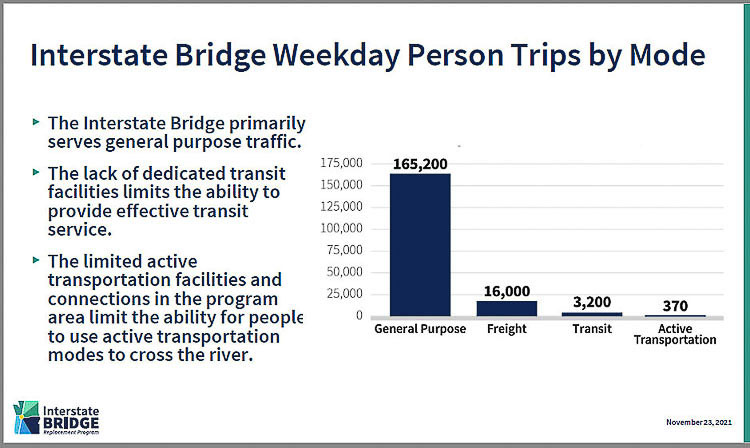
Will the proposal actually reduce traffic congestion? That is the problem people overwhelmingly want resolved. Or will the expenditure of $3 to $5 billion merely be a platform for a “multimodal solution” that fails to provide the people what they want?
Hardesty and Peterson want to get people out of their cars, for their version of the solution. They believe making people pay to drive on existing roads will cause people to avoid using cars, thereby reducing congestion. They hope to charge tolls on all area highways and freeways.
Metro believes congestion pricing has the potential to help the greater Portland region meet the priorities outlined in the 2018 Regional Transportation Plan, including reducing congestion and improving mobility, reducing greenhouse gas emissions, and improving equity and safety outcomes.
Donaghy says he doesn’t want to get people out of their cars. He appears to understand people living north of the Columbia River have a different mindset about cars and transportation.
Also read:
Interstate Bridge replacement effort gets $36 million funding boost as community group grapples with options
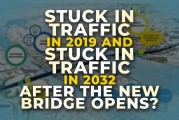
JoAnn Hardesty-Lynn Peterson letter to IBR Program raises concerns about ‘partnership’ for Vancouver City Council

A data driven Interstate Bridge solution 50 years into the future
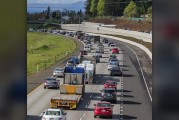
ODOT I-205 tolling effort moves forward, projecting a 12-hour reduction in traffic congestion by 2045
